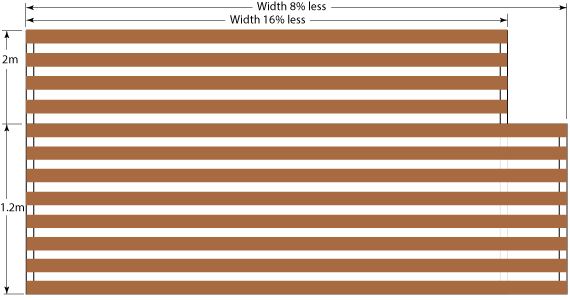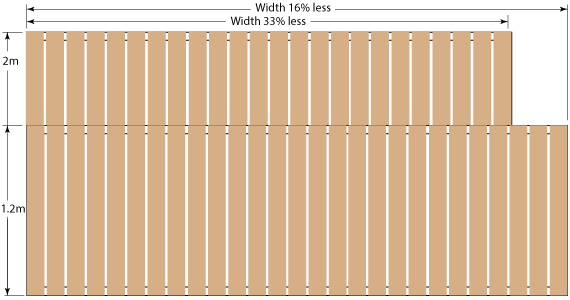
A Guide to Choosing the Correct Sized Motor for your Swinging (Hinged) Driveway Gate
When choosing a motor for a swinging driveway gate there are many factors to consider including: the width of the gate, what's on the gate, the hinges, posts, opening angle, speed and the amount of use a gate will get.
Swinging driveway gates must have good sturdy posts that don't pull over from the weight of the gate because if an automatic swing gate strikes the ground at all it won't work properly ... recommended Post Sizes for Swing Gates
Swinging Driveway Gates must also have two good solid hinges (not three) that don't rust up and become stiff and load the gate operator too much, swing gates should open and close easily ... more about swing gate hinges
Gate Width Rating for Swing Gate Motors
You will notice that all Swing Gate Motors listed on this website have a 'maximum gate width' rating. This rating is based on the gate being made with a light weight aluminium or steel frame that is no higher than 1.2m, has either vertical tubing or wire fitted to it with large gaps that lets wind blow through, opens to no more than 90o, is on level ground and the motor is installed for its maximum performance. If the gate is higher than 1.2m then the maximum rated gate width should be reduced by up to 8% at 2m high.

Reducing the Rated Gate Width by 16%
If a Gate has a light weight aluminium or steel frame no higher than 1.2m with either: slats, hardwood battens or timber palings fitted but with large gaps between them so they let some wind blow through, opens no more than 90o, is on level ground and the motor is set up for maximum performance then the maximum rated width of the gate should be reduced by 8% to compensate for the extra weight and wind resistance. If the gate is higher than 1.2m then the maximum rated gate width should be reduced by more, up to 16% for a gate 2m high.

Reducing the Rated Gate Width by 33%
If a gate has a frame no higher than 1.2m fitted with slats, battens, palings or sheeting with little or no gap that lets no wind blow through and adds quite a bit of weight to the gate, with the gate opening no more than 90o, is on level ground and the motor is set up for maximum performance then the maximum rated gate width should be reduced by 16%. If the gate is higher than 1.2m then the maximum rated gate width should be reduced by more, up to 33% for a gate 2m high.

Other Factors reducing the Rated Gate Width
If the opening angle of the gate is more than 90o then the maximum rated width of the gate must be reduced because the motors ability to push the gate is reduced, which adds to any reduction due to other factors such as gate weight or what's fitted to it. Every 10o over 90o reduces the maximum rated gate width by 5% so if you have gate opening to 130o then the maximum width of gate will be reduced by 20% than if it was opening 90o. If the gate has timber palings and is 1.8m high then this will be reduced by a further 30% or so making it a total of a 50% reduction so a 3m wide double swing gate with timber palings that is to open 130o requires a motor rated for a gate 3m wide per side.
If the speed of the gate is increased by setting the motor up to not use its full stroke length or rotating angle then the maximum width of the gate is reduced too. A 10% increase in speed will reduce the maximum width of the gate by 10% and 20% by 20% so it is proportional and once again adds to any reduction from opening angle, weight of the gate or what is fitted to the gate.
Rising Gates reducing the Rated Gate Width
With Swing Gates with Rising Hinges the more the gate rises and the heavier the gate is the more the maximum rated gate width is reduced, because the motor will need to lift a portion of the weight of the gate. This reduction also adds to any reduction due to all the other factors mentioned on this page.
The formula for calculating the reduction in maximum rated gate width for a swing gate motor, based on years of experience installing rising gates is:
Rated Gate Width = Rated Gate Width - Rated Gate Width x (amount of rise x weight factor / actual gate Width)).
The weight factor depends on the material that is fitted to the gate and includes:
- Aluminium frame with aluminium vertical tubing spaced 100mm apart has a weight factor of 1
- Thin walled steel frame with thin walled vertical steel tubing spaced at 100mm apart has a weight factor of 1.5
- Aluminium frame with aluminium slats that have a gap between them the same width as the slat ie. 65mm width slat with a 65mm wide gap has a weight factor of 2
- Aluminium frame with aluminium slats with gap up to 10mm between them has a weight factor of 3.5
- Thin walled (1mm) steel or thick wall aluminium (3mm) frame with pine palings fitted that have a 20mm gap between them have a weight factor of 3.
- Thin walled (1mm) steel or medium walled aluminium (3mm) frame with hardwood palings 19mm thick fitted that have a 20mm gap between them have a weight factor of 4.
- Medium walled steel (2mm) or thick walled aluminium (6mm) with thick hardwood battens ie. 40mm square set 40mm apart will have a weight factor of 6
For example if we have a double gate 4m wide (2m per side) with an aluminium frame and aluminium slats set with a 10mm gap this will have a weight factor of 3.5. So if this gate is to rise 200mm per side and we have an operator rated for gates to 3m the reduce maximum width because of the rise will be: 3 - 3 x (0.2 x 3.5/2) = 1.95m or 2m approximately so the operator rated for gates to 3m will work ok.